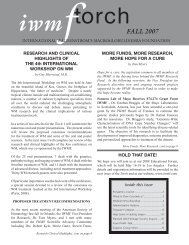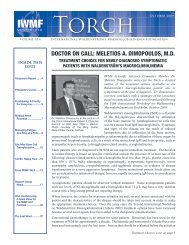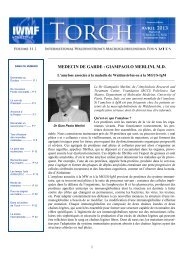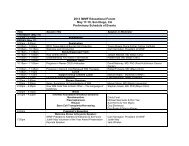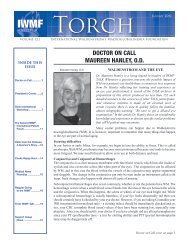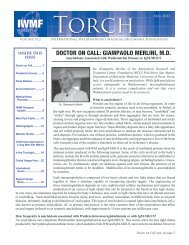English - International Waldenstrom's Macroglobulinemia Foundation
English - International Waldenstrom's Macroglobulinemia Foundation
English - International Waldenstrom's Macroglobulinemia Foundation
Create successful ePaper yourself
Turn your PDF publications into a flip-book with our unique Google optimized e-Paper software.
Doctor on Call, cont. from page 2<br />
In many cases no specific test can answer the question as<br />
to what caused the neuropathy. In some of these cases the<br />
neuropathy can be attributed to other diseases or conditions<br />
that a person has, such as diabetes, heavy alcohol consumption,<br />
or a cancer known to be associated with PN. In the case<br />
of Waldenstrom’s, we know that 48% of WM patients will<br />
develop neuropathy associated with WM. But keep in mind<br />
that neuropathy in a WM patient may be due to a number<br />
of reasons, including those listed above, and that it therefore<br />
can still be difficult to diagnose whether the PN is from WM.<br />
The only way to be certain is to test to see if the abnormal<br />
antibodies that directly attack the peripheral nerves are in<br />
your blood. There are several IgM antibodies that have been<br />
associated in this way, such as anti-MAG (Myelin Associated<br />
Glycoprotein) or sulfatide (a sulfur-containing lipid [fat]<br />
associated with the myelin layer). In our study of 119 patients<br />
with WM only 5% had antibodies to MAG and only 4% had<br />
antibodies to sulfatide. So it is important to rule out other<br />
causes of PN even if you have WM.<br />
How is Peripheral Neuropathy treated?<br />
The treatments for PN are directed at their underlying cause.<br />
So if the patient has diabetes, the best treatment is to control<br />
blood sugar, follow an appropriate diet, and exercise. If a<br />
patient has a vitamin deficiency then this can be corrected.<br />
If the PN is caused by one of the abnormal proteins in the<br />
blood, then lowering the level of the antibody in the blood<br />
will treat the PN. The antibody level can be lowered using<br />
chemotherapy or by directly removing the antibodies through<br />
plasmapheresis. These treatments may lower the level of the<br />
IgM; however, plasmapheresis is both time consuming and<br />
expensive and its effect is of short duration. Moreover, most<br />
patients with peripheral neuropathies have relatively mild<br />
symptoms that do not progress to severe neuropathies, and<br />
there is not much evidence to show that starting therapy with<br />
chemotherapy or plasmapheresis for a mild neuropathy will<br />
delay the progression to a more severe neuropathy. Most<br />
cases of PN associated with abnormal antibodies are mild and<br />
remain that way. So it is rarely worth the risk of aggressive<br />
therapy early on. Such decisions should be discussed with<br />
a doctor familiar with these types of neuropathies, in other<br />
words with a neurologist who specializes in diseases of the<br />
peripheral nerves.<br />
Even if there is no specific treatment for the underlying cause<br />
of the neuropathy, there are many treatments available that<br />
reduce the pain and the symptoms of PN. Such treatments are<br />
very commonly used in all forms of neuropathy and include<br />
amitriptiline, gabapentin, pregabalin and duloxetine. These<br />
agents can reduce the symptoms of PN by up to 50%. If<br />
the pain is uncontrollable even when these drugs are taken,<br />
then many patients will use narcotic medications such as<br />
oxycodone or methadone to reduce their pain. In these cases<br />
it is preferable to be followed by a pain specialist who can<br />
track the medications and their side effects. The key thing<br />
to keep in mind is that even without specific therapy for the<br />
cause of the neuropathy doctors should be able to improve<br />
your quality of life.<br />
Which treatments for WM are known to cause PN?<br />
This is a complicated subject since we know WM can cause<br />
PN, but we also know that some of the treatments for WM<br />
also cause or intensify PN symptoms. Several chemotherapy<br />
drugs including Vincristine, Velcade, Thalidomide, and<br />
Revlimid can cause PN. In most cases the likelihood that<br />
PN will develop during treatment is increased if there is even<br />
a mild PN before treatment. Further, if the drugs are the<br />
cause of the PN then the symptoms of PN tend to develop<br />
during the months of treatment. If symptoms of PN develop<br />
during chemotherapy it is important to notify your doctor<br />
immediately since stopping the chemotherapy can stop the<br />
progression of the PN or even reverse the symptoms. The<br />
decision to use the agents that cause PN has to be balanced<br />
against the need to treat Waldenstrom’s and should be<br />
discussed with your doctor.<br />
Peripheral neuropathy associated with Waldenstrom’s is<br />
a complex disorder, and there are many people with WM<br />
who suffer from neuropathy. The following are steps that<br />
will help formulate a treatment plan for the WM patient<br />
with neuropathy. Note, however, that the same steps are<br />
recommended to the patient who is experiencing neuropathy<br />
but who does not have WM.<br />
1) Establish that PN is the accurate cause of the symptoms.<br />
2) Establish whether WM is the likely cause for the PN or if<br />
there are other causes.<br />
3) Direct therapy based on the severity of symptoms, i.e. in<br />
cases of severe neuropathy related to WM patients need<br />
aggressive therapy to reduce antibody levels; in cases of<br />
mild PN symptomatic therapy may be all that is required.<br />
4) Follow routinely with a neurologist familiar with disorders<br />
of the peripheral nervous system.<br />
These steps will help ensure that everything that can be done<br />
will be done to treat your PN.<br />
Dr. Levine is at present Assistant Professor of Clinical<br />
Neurology at the University of Arizona and in private<br />
practice with Phoenix Neurological Associates in Phoenix.<br />
He is board-certified by the American Board of Psychiatry<br />
and Neurology (1998) and the American Board of<br />
Electrodiagnostic Medicine (2000). He is currently Co-<br />
Director of the Samaritan Peripheral Neuropathy Center,<br />
Co-Director of the Samaritan ALS Clinic, and Director of<br />
the Department of Neurophysiology at the Good Samaritan<br />
Hospital in Phoenix.<br />
After earning his medical degree from Duke University School<br />
of Medicine in Durham, NC, he completed his internship<br />
in internal medicine at the Jewish Hospital of St. Louis,<br />
Doctor on Call, cont. on page 4<br />
IWMF TORCH Volume 11.2<br />
3






